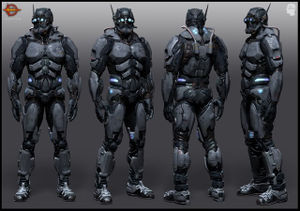
Developed by Excalibur Inc. for deployment in highly dangerous combat zones, the Advanced Cybernetic Exoskeleton or ACE battle armor is a unique bled of traditional and and advanced cybernetic technology. In the base of the neck within the armor are neural transceivers as well as throughout the helmet. These devices allow information from the armor to be directly communicated to the brain of the wearer. If the wearer has existing cybernetic implants the armor is able to directly communicate with them.
Construction
The armor is constructed using overlapping layers of a nano-polymer mesh similar to kevlar but much stronger. This is then covered by a carbon nano-fiber mesh with maintains a tight pressure along the skin, allowing the wearer to experience sudden explosive decompression and hard vacuum without major impact.
The outside of the armor is a honeycomb mesh of titanium-core and nano-carbon-tubes which are suspended in an energy absorbent / impact resistant polymer.
Cybernetic Components
Throughout the armors construction from skin to the outer surface are cybernetic pathways which allow the armor to be aware of the status of its occupant and its own damage. Within these pathways are built in microprocessors connected via the armors mesh network and ultimately controlled by the occupant of the armor. This allows the armor to react within itself and alters the shape and tension of layers and areas within to react to anticipation of damage from the wearer.
Features
The armor is considered to be smart armor in that it has a computer component which is aware of its occupant and its own state (damage, etc). The armor's computer operates as a mesh network so that is no central computer system. It has the ability to interface with weapons and communications devices to provide the wearer a central interface with ammunition, communication, and sensors.
Shields
Personal energy shields are powered by individual batteries located throughout the armor along with a micro-fusion core at the back of the armor. The shield system provides high level protection from projectile and energy weapons but requires time to recharge after repeated hits in a short time span.
Senses
Sensors and cameras at the face make the armor able to see in the same ways as the Multi-Optic Eye cybernetic implant. Additionally, along the armors entire surface are proximity, heat, and motion sensors giving the wearer the ability to sense potential incoming attacks and thus far more difficult to surprise.
Motor Assistance
Motor assist units are placed throughout the armor at key joints. The armor is able to assist its occupant in running, climbing, grappling, and other standard.
Pressure Assistance
Tension and pressure control along critical stress lines throughout the body also allow the armor to assist in heavy lifting and high / low pressure environments.
Antigravity Flight
The armor can also be equipped with an antigravity jet pack, attached to the back of the armor. The pack allows the wearer to neutralize gravitational forces and then uses small thrusters to fly.
Submerged Functionality
Although not as common, the suits systems are also designed to operate submerged in a variety of liquids, most commonly water or a substance with similar properties. The suit itself can withstand pressures in excess of 350 MPa indefinitely so long as the pressure is relatively uniform over 95% of the armors surface. Effectiveness of protection drops significantly the less uniform the pressure is over the surface.
Under STP surface conditions and submerged in salt water (or similarly dense substance), the armor functions normally at depths up to around 32km. The suit has a maximum crush depth of 35km, beyond that structural integrity will be quickly compromised. Additional restrictions can vary depending on the specific conditions in the area.
Life Support
In toxic or hazardous environments the armor can act as a life support unit, providing oxygen to breath and advanced air filtration systems. In a hard vacuum the armor can provide approximately 8 hours of oxygen through a rebreather system.
Medical Assist
If the occupant has suffered serious injuries the armor is capable of acting as a nano-medical repair unit and deploy Nanites directly into the persons blood stream to conduct repairs and try to keep the person alive. If the occupant is bleeding the armor will attempt to apply increased pressure to that area while deploying nanites. Micro-replicators within the armor allow for small doses of pain killers and stimulants as well.
Surveilling Drones
The armor is capable of launching up to 4 Short Range Tactical Surveilling Drone's at a time. These are used for a variety of purposes, including remote targeting and getting detailed information on enemy movements / nearby terrain. The drones can be directly controlled via a holographic interface or via voice commands given over the COM system.